2009 Hyundai Santa Fe radiator
[x] Cancel search: radiatorPage 65 of 269

1FEATURES OF YOUR HYUNDAI
54
!
OCM029011L
INSTRNMENT CLUSTER
B280A01A-AAT Fuel Gauge The needle on the gauge indicates the approximate fuel level in the fuel tank.The fuel capacity is given in Section 9. B290A02A-DAT Engine Coolant Temperature Gauge
OCM029012L
WARNING:
Never remove the radiator cap when the engine is hot. The engine coolantis under pressure and could erupt and cause severe burns. Wait until the engine is cool before removingthe radiator cap.
B270A01A-AAT BRAKE PAD WEAR WARNING SOUND The front disc brake pads have wear indicators that should make a high-pitched squealing or scraping noise when new pads are needed. The sound may come and go or be heard all thetime when the vehicle is moving. It may also be heard when the brake pedal is pushed down firmly. Excessive rotordamage will result if the worn pads are not replaced. See your Hyundai dealer immediately.
B265A01FC-GAT
Fuel Filter Warning Light (Diesel Engine)
This light illuminates when the engine has started and goes off after a fewseconds. If it lights up while the engine is running, it indicates that water has accumulated inside the fuel filter. If thishappens, remove the water from the fuel filter. (Refer to "6-27 page")
CM-aust-1a.p65 5/21/2008, 2:06 PM
54
Page 99 of 269
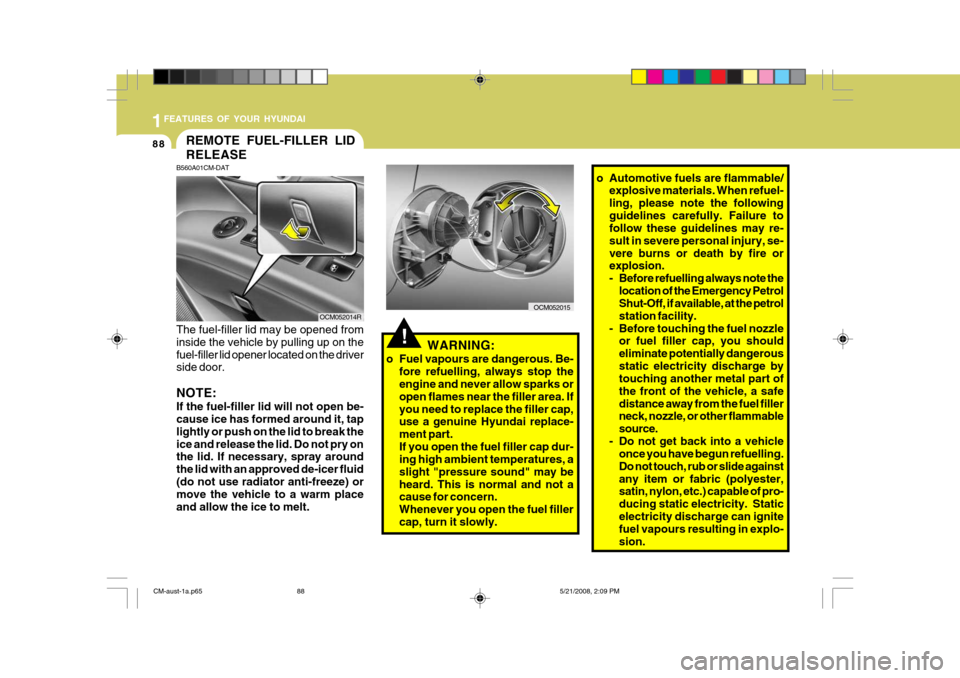
1FEATURES OF YOUR HYUNDAI
88
!WARNING:
o Fuel vapours are dangerous. Be- fore refuelling, always stop the engine and never allow sparks or open flames near the filler area. Ifyou need to replace the filler cap, use a genuine Hyundai replace- ment part.If you open the fuel filler cap dur- ing high ambient temperatures, a slight "pressure sound" may beheard. This is normal and not a cause for concern. Whenever you open the fuel fillercap, turn it slowly.
REMOTE FUEL-FILLER LID RELEASE
B560A01CM-DAT The fuel-filler lid may be opened from inside the vehicle by pulling up on thefuel-filler lid opener located on the driver side door. NOTE: If the fuel-filler lid will not open be- cause ice has formed around it, tap lightly or push on the lid to break theice and release the lid. Do not pry on the lid. If necessary, spray around the lid with an approved de-icer fluid(do not use radiator anti-freeze) or move the vehicle to a warm place and allow the ice to melt. OCM052014R
OCM052015
o Automotive fuels are flammable/
explosive materials. When refuel- ling, please note the followingguidelines carefully. Failure to follow these guidelines may re- sult in severe personal injury, se-vere burns or death by fire or explosion.
- Before refuelling always note the
location of the Emergency Petrol Shut-Off, if available, at the petrol station facility.
- Before touching the fuel nozzle or fuel filler cap, you shouldeliminate potentially dangerousstatic electricity discharge by touching another metal part of the front of the vehicle, a safedistance away from the fuel filler neck, nozzle, or other flammable source.
- Do not get back into a vehicle once you have begun refuelling.Do not touch, rub or slide againstany item or fabric (polyester, satin, nylon, etc.) capable of pro- ducing static electricity. Staticelectricity discharge can ignite fuel vapours resulting in explo- sion.
CM-aust-1a.p65 5/21/2008, 2:09 PM
88
Page 179 of 269

3WHAT TO DO IN AN EMERGENCY
4
!
IF THE ENGINE OVERHEATS
4. Check to see if the water pump drivebelt is missing. If it is not missing, check to see that it is tight. If the drive belt seems to be satisfactory, check for coolant leaking from theradiator, hoses or under the car. (If the air conditioning had been in use, it is normal for cold water to bedraining from it when you stop).
D030A02TB-DAT If your temperature gauge indicates overheating, you experience a loss of power, or hear loud pinging or knocking, the engine is probably too hot. If thishappens to you, you should:
1. Pull off the road and stop as soon as
it is safe to do so.
2. Place the gear selector lever in "P"
(automatic), or neutral (manual transaxle) and set the parking brake. If the air conditioning is on, turn it off.
3. If coolant is running out under the car or steam is coming out from underthe bonnet, stop the engine. Do not open the bonnet until the coolant hasstopped running or the steaming has stopped. If there is no visible loss of coolant and no steam, leave theengine running and check to be sure the engine cooling fan is operating. If the fan is not running, turn the engineoff. WARNING:
While the engine is running, keephands and clothing away from mov-ing parts such as the fan and drive belts to prevent injury.
5. Start the engine in the car with the
discharged battery using the normal starting procedure. After the enginestarts, leave the jumper cables con- nected and let the engine run at fast idle or about 2000 rpm for severalminutes.
6. Carefully remove the jumper cables
in the reverse order of attachment.
If you do not know why your batterybecame discharged (because the lightswere left on, etc.), have the charging system checked by your Hyundai dealer.
CM-aust-3.p65 5/19/2008, 6:35 PM
4
Page 180 of 269

3
WHAT TO DO IN AN EMERGENCY
5
!
5. If the water pump drive belt is broken
or coolant is leaking out, stop the engine immediately and call the near- est Hyundai dealer for assistance. WARNING:
Do not remove the radiator cap whenthe engine is hot. This can allowcoolant to be blown out of the open- ing and cause serious burns.
!WARNING (DIESEL ONLY):
Never work on injection system with engine running or within 30 secondsafter shutting off engine. High pres- sure pump, rail, injectors and high pressure pipes are subject to highpressure even after the engine stopped. The fuel jet produced by fuel leaks may cause serious injury,if it touch the body. People using pacemakers should not move than 30cm closer to the ECU or wiringharness within the engine room while engine is running, since the high currents in the Common Rail systemproduce considerable magnetic fields. 6. If you cannot find the cause of the
overheating, wait until the engine temperature has returned to normal. Then, if coolant has been lost, care- fully add coolant to the reservoir(page 6-10) to bring the fluid level in the reservoir up to the halfway mark.
7. Proceed with caution, keeping alert for further signs of overheating. Ifoverheating happens again, call a Hyundai dealer for assistance.
CAUTION:
Serious loss of coolant indicatesthere is a leak in the cooling system and this should be checked as soon as possible by a Hyundai dealer.
!
SPARE TYRE
D040A01CM-DAT TEMPORARY SPARE TYRE The following instructions for the tem- porary spare tyre should be observed:
1. Check inflation pressure as soon as possible after installing the spare tyre, and adjust to the specified pres- sure. The tyre pressure should be periodically checked and maintainedat the specified pressure while the tyre is stored.
Spare Tyre Pressure
Tyre Size
Inflation PressureT165/90R17
420 kPa (60 psi)
2. The spare tyre should only be used temporarily and should be returned to the spare tyre carrier as soon as the original tyre can be repaired or replaced.
3. Continuous use at speeds of over 80 km/h (50 mph) is not recommended.
4. As the temporary spare tyre is spe-
cifically designed for your car, it should not be used on any other vehicle.
CM-aust-3.p65 5/19/2008, 6:35 PM
5
Page 205 of 269
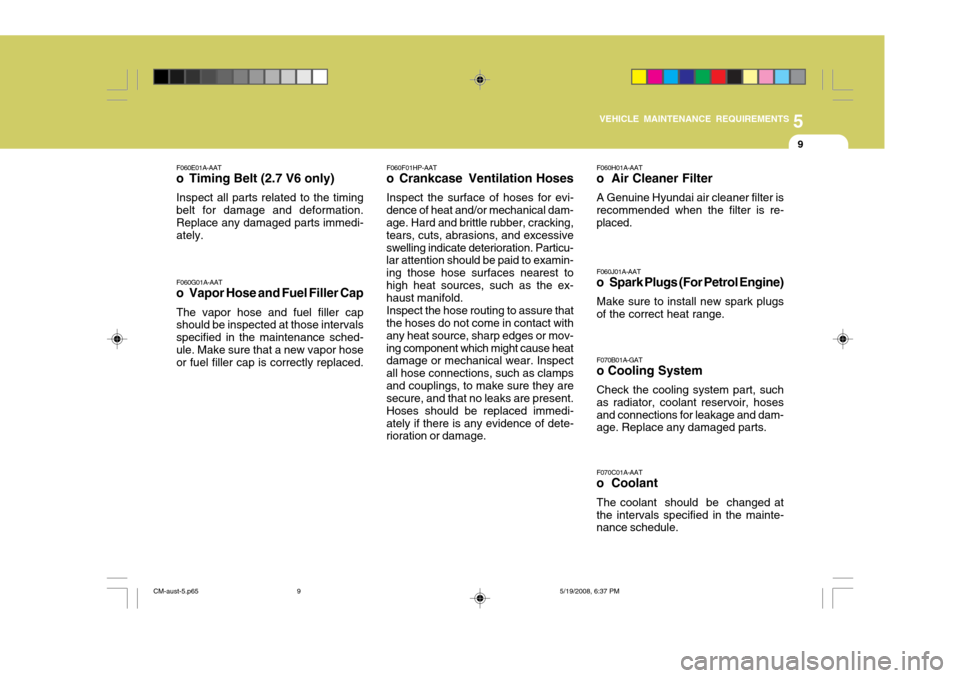
5
VEHICLE MAINTENANCE REQUIREMENTS
9
F060E01A-AAT
o Timing Belt (2.7 V6 only)
Inspect all parts related to the timing belt for damage and deformation. Replace any damaged parts immedi- ately. F060G01A-AAT
o Vapor Hose and Fuel Filler Cap
The vapor hose and fuel filler cap should be inspected at those intervals specified in the maintenance sched-ule. Make sure that a new vapor hose or fuel filler cap is correctly replaced. F060F01HP-AAT
o Crankcase Ventilation Hoses
Inspect the surface of hoses for evi-
dence of heat and/or mechanical dam-age. Hard and brittle rubber, cracking, tears, cuts, abrasions, and excessiveswelling indicate deterioration. Particu- lar attention should be paid to examin- ing those hose surfaces nearest tohigh heat sources, such as the ex- haust manifold.
Inspect the hose routing to assure that
the hoses do not come in contact with any heat source, sharp edges or mov-ing component which might cause heat damage or mechanical wear. Inspect all hose connections, such as clampsand couplings, to make sure they are secure, and that no leaks are present. Hoses should be replaced immedi-ately if there is any evidence of dete- rioration or damage. F060H01A-AAT
o Air Cleaner Filter
A Genuine Hyundai air cleaner filter is recommended when the filter is re- placed. F060J01A-AAT
o Spark Plugs (For Petrol Engine)
Make sure to install new spark plugs of the correct heat range. F070C01A-AAT
o Coolant
The coolant should be changed at the intervals specified in the mainte- nance schedule.
F070B01A-GAT o Cooling System Check the cooling system part, such as radiator, coolant reservoir, hosesand connections for leakage and dam- age. Replace any damaged parts.
CM-aust-5.p65
5/19/2008, 6:37 PM
9
Page 209 of 269
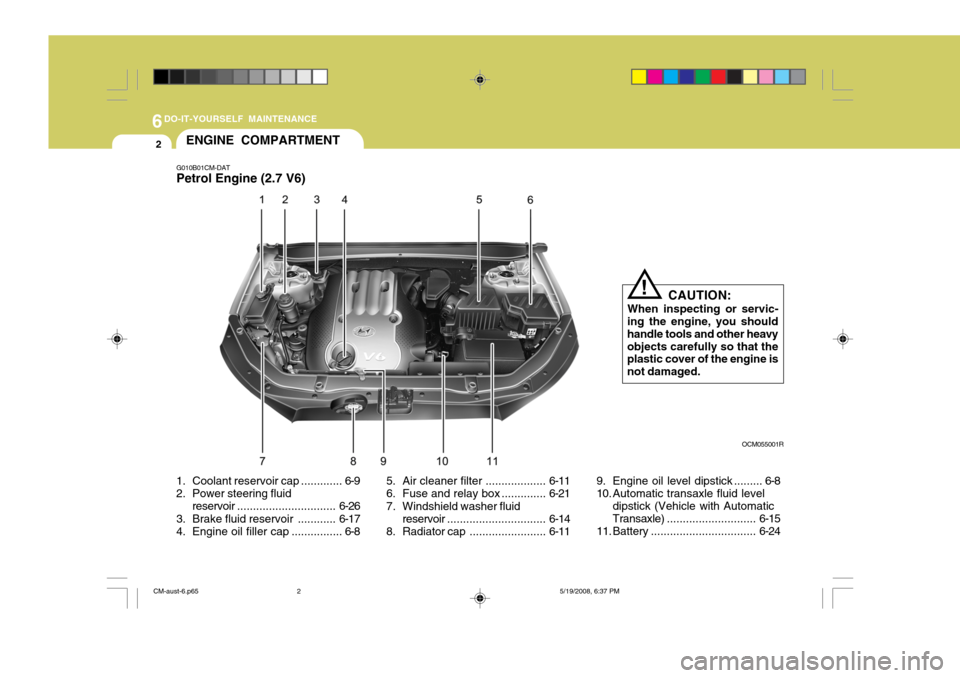
6DO-IT-YOURSELF MAINTENANCE
2ENGINE COMPARTMENT
1. Coolant rese rvoir cap ............. 6-9
2. Power steering fluid
reservoir ............................... 6-26
3. Brake fluid reservoir ............ 6-17
4. Engine oil filler cap ................ 6-8 5. Air cleaner filter ...................
6-11
6. Fuse and relay box .............. 6-21
7. Windshield washer fluid reservoir ............................... 6-14
8. Radiator cap ........................6-11
G010B01CM-DAT Petrol Engine (2.7 V6)
9. Engine oil level dipstick ......... 6-8
10. Automatic transaxle fluid leveldipstick (Vehicle with AutomaticTransaxle) ............................ 6-15
11. Battery ................................. 6-24
CAUTION:
When inspecting or servic-
ing the engine, you shouldhandle tools and other heavyobjects carefully so that the plastic cover of the engine is not damaged.
!
OCM055001R
CM-aust-6.p65 5/19/2008, 6:37 PM
2
Page 211 of 269
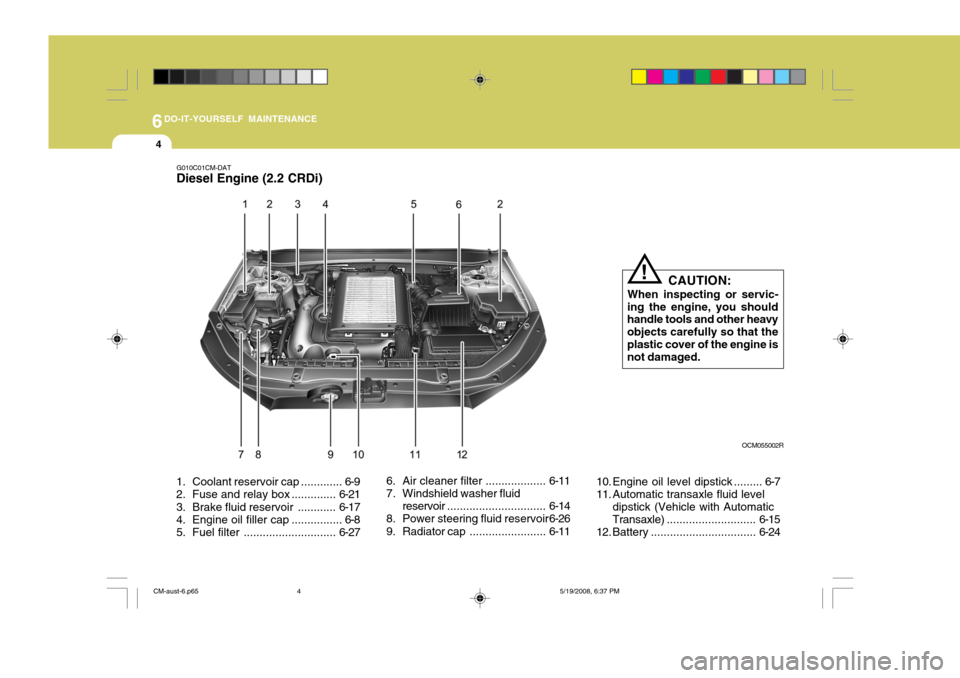
6DO-IT-YOURSELF MAINTENANCE
4
1. Coolant rese rvoir cap ............. 6-9
2. Fuse and relay box .............. 6-21
3. Brake fluid reservoir ............ 6-17
4. Engine oil filler cap ................ 6-8
5. Fuel filter ............................. 6-276. Air cleaner filter ...................
6-11
7. Windshield washer fluid
reservoir ............................... 6-14
8. Power steering fluid reservoir 6-26
9. Radiator cap ........................6-1110. Engine oil level dipstick ......... 6-7
11. Automatic transaxle fluid level
dipstick (Vehicle with AutomaticTransaxle) ............................ 6-15
12. Battery ................................. 6-24
G010C01CM-DAT
Diesel Engine (2.2 CRDi)
CAUTION:
When inspecting or servic-
ing the engine, you should handle tools and other heavy objects carefully so that theplastic cover of the engine is not damaged.
!
OCM055002R
CM-aust-6.p65 5/19/2008, 6:37 PM
4
Page 215 of 269
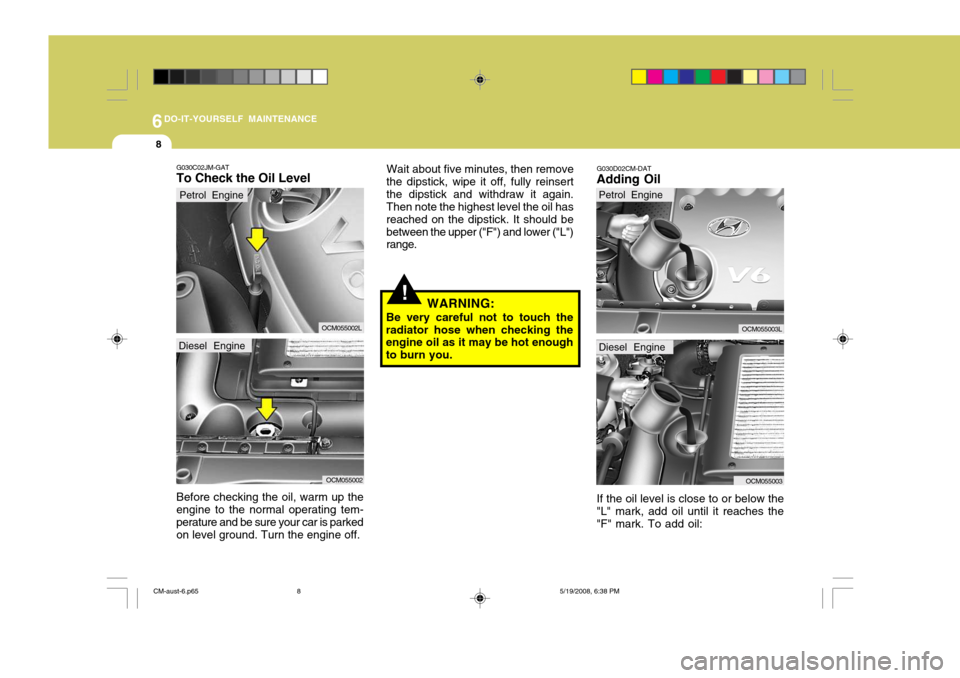
6DO-IT-YOURSELF MAINTENANCE
8
!
G030C02JM-GAT To Check the Oil Level
WARNING:
Be very careful not to touch the
radiator hose when checking the engine oil as it may be hot enough to burn you.
Before checking the oil, warm up theengine to the normal operating tem- perature and be sure your car is parked on level ground. Turn the engine off.
Diesel Engine OCM055002
Petrol Engine
OCM055002LWait about five minutes, then remove
the dipstick, wipe it off, fully reinsert the dipstick and withdraw it again. Then note the highest level the oil has reached on the dipstick. It should bebetween the upper ("F") and lower ("L") range.
OCM055003
OCM055003L
Petrol Engine
Diesel Engine
G030D02CM-DAT
Adding Oil
If the oil level is close to or below the
"L" mark, add oil until it reaches the "F" mark. To add oil:
CM-aust-6.p65 5/19/2008, 6:38 PM
8